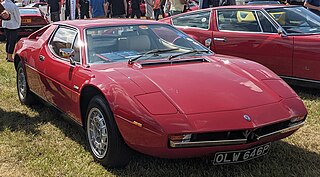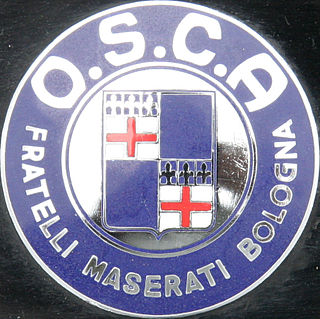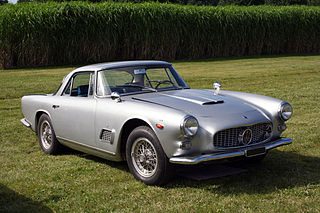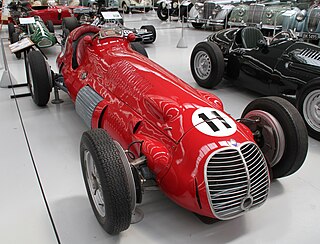
Dino was a marque best known for mid-engined, rear-drive sports cars produced by Ferrari from 1957 to 1976. The marque came into existence in late 1956 with a front-engined Formula Two racer powered by a brand new Dino V6 engine. The name Dino was used for some models with engines smaller than 12 cylinders, it was an attempt by the company to offer a relatively low-cost sports car. The Ferrari name remained reserved for its premium V12 and flat-12 models until 1976, when "Dino" was retired in favour of full Ferrari branding.

The Chevrolet small-block engine is a series of gasoline-powered V8 automobile engines, produced by the Chevrolet division of General Motors between 1954 and 2003, using the same basic engine block. Referred to as a "small-block" for its size relative to the physically much larger Chevrolet big-block engines, the small-block family spanned from 262 cu in (4.3 L) to 400 cu in (6.6 L) in displacement. Engineer Ed Cole is credited with leading the design for this engine. The engine block and cylinder heads were cast at Saginaw Metal Casting Operations in Saginaw, Michigan.

The Nissan A series of internal combustion gasoline engines have been used in Datsun, Nissan and Premier brand vehicles. Displacements of this four-stroke engine family ranged from 1.0-liter to 1.5-liter and have been produced from 1967 till 2009. It is a small-displacement four-cylinder straight engine. It uses a lightweight cast iron block and an aluminum cylinder head, with overhead valves actuated by pushrods.

The Maserati Merak is a mid-engined 2+2 sports car produced by Maserati between 1972 and 1983. The Merak was closely related to the Maserati Bora, sharing part of its structure and body panels, but was powered by a 3.0 L V6 in place of the latter's 4.7 L V8. The extra cabin space gained by fitting a smaller and more compact powertrain was used to carve out a second row of seats—suitable for children or very small adults—making the Merak not just a less expensive alternative to the Bora but also a 2+2.

O.S.C.A. was an Italian manufacturer of racing and sports cars established 1947 in San Lazzaro di Savena, Bologna, by the Maserati brothers, and closed down in 1967. The company name is usually written OSCA or Osca.

The Maserati 3500 GT and the Maserati 3500 GT Spyder are 2-door coupé and convertible grand tourers made by Italian car manufacturer Maserati between 1957 and 1964. It was a seminal vehicle for Maserati as the company's first successful attempt at the Gran Turismo market and series production.

Maserati A6 were a series of grand tourers, racing sports cars and single seaters made by Maserati of Italy between 1947 and 1956. They were named for Alfieri Maserati and for their straight-six engine.

Maserati 150S is a racing car made by Maserati of Italy alongside the Maserati 200S, to take over for the aging Maserati A6GCS racing variants. Depending on the source, between twenty-four and twenty-seven examples were built, and one additional street-going car, called the Maserati 150 GT.

The Maserati Tipo 60/61 are a series of sports racing cars produced between 1959 and 1961 by Italian automobile manufacturer Maserati for privateers racing in sports car events including the 24 Hours of Le Mans in the 2-litre and 3-litre racing category. It used an intricate tubular space frame chassis, containing about 200 chro-moly steel tubes welded together, arranged triangular formation at high stress areas of the chassis, hence the nickname "Birdcage". This method of construction provided a more rigid and, at the same time, lighter chassis than other racing cars of the time.

Formula 1000 (F1000) is a class of open wheel formula racing with professional and amateur series worldwide. Formula 1000 gets its name from the 1000 cc super-bike engine used to power a single seat, open wheel race car with fully adjustable wings and suspension.

The ALFA 40/60 HP is a road car and race car made by Italian car manufacturer ALFA. This model was made between 1913 and 1922 and was designed by Giuseppe Merosi, as were all other Alfas at that time. The 40/60 HP has a 6082 cc straight-four engine with overhead valves, which produced 70 PS (51 kW) and its top speed was 125 km/h (78 mph). The 40-60 HP Corsa racing version had 73 PS (54 kW) and a top speed of 137 km/h (85 mph), and it also won its own category in the Parma-Berceto race.

The Maserati 4CL and its derived sister model the Maserati 4CLT are single-seat open-wheel Grand Prix racing cars that were designed and built by Maserati. The 4CL was introduced at the beginning of the 1939 season, as a rival to the Alfa Romeo 158 and various ERA models in the voiturette class of international Grand Prix motor racing. Although racing ceased during World War II, the 4CL was one of the front running models at the resumption of racing in the late 1940s. Experiments with two-stage supercharging and tubular chassis construction eventually led to the introduction of the revised 4CLT model in 1948. The 4CLT was steadily upgraded and updated over the following two years, resulting in the ultimate 4CLT/50 model, introduced for the inaugural year of the Formula One World Championship in 1950. In the immediate post-war period, and the first two years of the Formula One category, the 4CLT was the car of choice for many privateer entrants, leading to numerous examples being involved in most races during this period.

The Fiat-Abarth 750 is a compact sporting series of automobiles manufactured by the Italian manufacturing firm Abarth & C. of Turin, Italy in the 1950s and 1960s. The cars used the floorpan and often the bodywork of the Fiat 600 but were fitted with Abarth's modified engines. Abarth also offered a number of bodyworks by other designers for the 750 and its derivatives, most famously Zagato but also Allemano and others.

The Maserati 250S, and its derivative and version, the 250 Sport, are sports racing cars, designed, developed and built by Italian car manufacturer Maserati, between 1954 and 1957. Only two models were produced.
The Ferrari flat-12 engine family is a series of flat-12 DOHC petrol engines produced by Ferrari from 1964 to 1996. The first racing Ferrari flat-12, the Mauro Forghieri-designed Tipo 207, was introduced in the Ferrari 1512 F1 car in 1964. Later flat-12 racing engines were used in Ferrari Formula One and sports racing cars from 1968 until 1980, including the 212 E Montagna, 312 B series, 312 PB and 312 T series. The roadgoing flat-12 engines were introduced with the 365 GT4 BB and were produced in various versions until the end of F512M production in 1996.

Vittorio Jano designed a new 60° V12 engine for sports car racing for Ferrari. This new engine, introduced in 1956, combined elements of both Colombo and Lampredi engines with new features. Engine architecture was more of Lampredi school but retained smaller Colombo internal measurements. Jano moved to Ferrari along with his designs for the Lancia D50 in 1955 and went on to design not only a new V12 but also a family of the Dino V6 engines soon after. Some of the technical ideas came from the Jano's Lancia V8 DOHC engine, intended for Formula One. This family of engines replaced Lampredi inline-4s known from Ferrari Monza line and went on to win many international races and titles for Ferrari. The design team comprised Jano as well as Vittorio Bellentani, Alberto Massimino, and Andrea Fraschetti.

The Maserati 150 GT was a prototype sports car produced by Maserati in 1957. Derived from the four-cylinder Maserati 150S race car, it was a singular road-going example, and was given spyder bodywork.
Maserati made two naturally-aspirated, straight-6, racing engines, designed for Formula One; between 1952 and 1960. The first engine was the 2.0-liter A6G; in accordance with the engine regulations imposed by the FIA. Their second and last engine was the 250 F1; in accordance with the engine regulations imposed by the FIA for 1954. Several of these engines, or derivatives of these engines, were also used in various Maserati sports cars.
The Maserati 8CL is an open-wheel Grand Prix motor racing car, designed, developed and built by Italian manufacturer Maserati, from 1940 through 1946. Only two models were produced.

The Maserati 8CLT is an open-wheel race car, designed, developed and built by Italian manufacturer Maserati in 1950, conforming to Formula One rules and regulations of the time, set by the FIA.





















